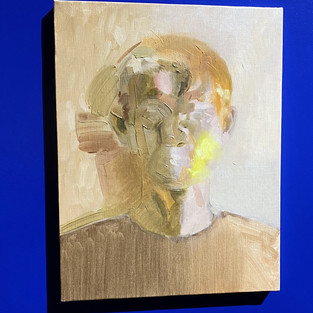2020 Daejeon Biennale: 'A.I. Sunshine Misses Windows' at the Daejeon Museum of Art
- mckenziejohns
- May 23, 2020
- 4 min read
Updated: Oct 4, 2020
On-view until October 10, the Daejeon Biennale focuses on the role of artificial intelligence in contemporary artistic creation and viewership.

Quayola, remains: Vallée fr Joux, 2018, series of inkjet prints
Background on Daejeon Biennale
Formerly known as 'Project Daejeon,' the Daejeon Biennale is a biannual art project that has explored the integration of technology, nature, and human creativity since its inception as 'Daejeon FAST' in 2000. This year's theme centers around the role of artificial intelligence in the contemporary artistic process. With art from sixteen artists and art-making teams that hail from six different countries, the members of this exhibition explore new modes of artistic expression via A.I.. The participating artists come from various interdisciplinary fields and backgrounds including, but not limited to computer science and engineering in addition to the traditional field of visual art. The exhibition calls into question the role of the artist and viewer in a world that is increasingly influenced and dictated by A.I.
I will keep this review brief by highlighting three works I found most intriguing, but I invite anyone who is interested in learning more to check out the Daejeon Museum of Art's website and/or instagram page (https://www.daejeon.go.kr/dmae/DmaExhibView.do?exType=01&menuSeq=6124&exSeq=105218&&pageIndex=1).
Nonfacial Portrait, Shinseungback Kimyonghun (신승백 김용훈), 2018-2019
Shinseungback Kimyonghun is a Seoul-based duo who focus their work on the psychological phenomenon of paredolia, or the human tendency to lend significance--and often facial features--to inanimate objects and random patterns. For Nonfacial Portrait, the pair invited several artists paint portrait following only one guideline: the face must be unrecognizable to A.I. As the artists worked, a camera equipped with three facial recognition algorithms loomed overhead informing the painter when facial features could be detected. The interesting thing about the result is that, while each face is completely unrecognizable to A.I., it is immediately identifiable as a human by human viewers. Therefore, the below works expose an odd and unique human idiosyncrasy that separates us from artificial intelligence.
Shinseungback Kimyonghun, Nonfacial Portrait, 2018-2019, series of portraits in various media
Making Art--for Stock Market, teamVOID, 2017
teamVOID is a collective consisting of media artists Song Junbong (송준봉), Bae Jaehyuk (배재혁), and Seok Buyoung (석부영). The trio strives to fuse art and technology by designing experimental media including robots, kinetic sculpture, and light sculpture. For this 2017 work, the artists programmed a robot to process stock market data and, in turn, make a drawing as a performance piece. Thus, economic data becomes an artistic medium as tangible as ink or paint on canvas, and the stark boundary between the seemingly unrelated fields of finance and art is blurred. This work also resurrects the undying question that has permeated art history classes, exhibition halls, and art galleries for decades: "What is art?" and adds a second mind-bending question on top of it: "Who (or rather what) can be considered an artist?"

teamVOID, Making Art--for Stock Market, 2017
Facial Weaponization Suite, Zach Blas, 2012-2014
Zach Blas is an American artist, filmmaker, and writer based in London where he is a lecturer in the Department of Visual Cultures at Goldsmith's University of London. Though his practice "spans moving image, computation, theory, performance, and science fiction," Facial Weaponization Suite is a work of protest art that challenges inequalities propagated by biometric facial recognition technologies. By making "collective masks" that are modeled from the aggregated facial data of participants to make nebulous masks unrecognizable as human faces, wearers of the masks are able to chose to pass undetected by facial recognition technologies.
According to the artist, these masks "constitute a response to numerous developments in the field of facial recognition" via A.I., including studies that suggest the possibility of determining one's sexual orientation through rapid facial recognition technologies (read more here: https://blogs.scientificamerican.com/bering-in-mind/something-queer-about-that-face/), the racism inherent in biometric technologies unable to detect dark skin and non-white facial features, and gender discrimination regarding visibility at the US national security borderline.
By wearing a "collective mask," individuals are able to protest these inequalities by refusing to be "subsumed into dominant forms of political representation."
Zach Blas, Facial Weaponization Suite, 2012-2014
Overall Impression of the Biennale:
All in all, I found the works on view at the Daejeon Biennale to be yet another affirmation of the claim that some of the most cutting-edge displays of contemporary art are coming out of South Korea. Of course, I may be a little biased because this is my field of interest--however, the exhibition stuck true to its theme and left my mind reeling with thought the whole underground-ride home. Yet, one of my favorite things about the entire exhibition was the fact that you walked out of the biennale galleries into the museum's main atrium where Nam June Paik's Fractal Turtleship* is on display. Anyone who knows a bit about Paik's art will recognize that he was once the top avant-gardist of his day, questioning the place of technology in the artist's world. Thus, I found it sort of neat that his work was the first to greet visitors as they exited halls filled with work by our generation's avant-garde. It almost felt as if a metaphorical torch were being passed on to a rising cohort of artists with a call to keep questioning and keep innovating.

Nam Joon Paik, Fractal Turtleship, 1993
*(more to come later about Nam Joon Paik and this piece)
References and Further Reading:


























Comments